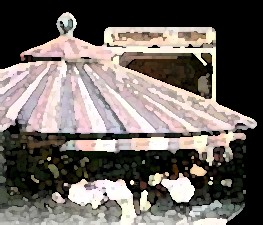For several
months they sought ways to restore the historic relic to use, finally getting in touch
with Robert Moses, the man in charge of New York’s World’s Fair. Yes, he did
remember the Feltman carousel. Once he, too,
had been a kid at Coney with a nickel in his jeans. Yes,
he was genuinely enthusiastic about placing the carousel at the World’s Fair grounds.
Possibly it could be kept there for the proposed future park, preserved for as long as
possible for the children of New York.
So the young
lawyers joined forces with a patent attorney and a Greenwich Village restaurateur, forming
the American Cavalcade Corporation to bring the Feltman’s Carousel to the
World’s Fair. Room was allocated at the
Lake Amusement Area on a landscaped lawn now named Carousel Park. There it stands regal and aloof, yet at home
beside an authentic outdoor “boardwalk” restaurant serving seaside treats like
hot dogs, clams and corn-on-the-cob.
There
were technical problems to solve, though, before the carousel’s opening on July 1. Feltman’s was not built during the modern
era. It was constructed at the turn of the
century, when Feltman’s restaurant was the social mecca of Coney, when horse-racing
attracted millionaires to
the shores of Brooklyn and champagne was a dime, on tap.
At that time the platform was powered by a
harnessed and belled white horse, the area illuminated with 4,000 gas lamps. After a day at the track, off-duty jockeys would
laughingly race Illions’ handsome steeds. At
times the saddles seated the shapely rumps ot the Ziegfield girls, or the staider
President William Howard Taft and W. K. Vanderbilt. The
horses strained under diamond-studded riders, while the military band-organ peeled out
roll after roll of popular songs, show-tunes and folk selection—in a continual,
exhilarating cacophony of nostalgia-breeding sound.
But this new
site was out-of-doors, and the Feltman not used to exposure. The original organ had been sold by the time the
young attorney first knocked on the warehouse door. So
the Corporation purchased an operative carousel from Coney Island—the
Stubman—also decorated by Illions, but rebuilt in 1923 and in perfect mechanical
condition. In 1953 it had been completely
fitted with a park-type, all-weather, revolving roof.
The wedding took place: the Stubman frame and the Feltman horses. And finally two military band organs were
installed, both of German make. The
Valdkirch, manufactured by Gabebruder Organ Fabrik, is reportedly the largest such organ
extant—450 reeds with complete woodwind and brass choir. Working on a compressed air and perforated paper
roll principle, much like a player piano, the two organs together can supply a full week
of music, without repetition.

